
In today’s fast-paced world, information is power and a well-built knowledge base is the ultimate weapon in the quest for knowledge. Wow, that came out like an epic movie trailer! But bear with us, because things get even better… Whether you’re a business looking to streamline customer support or an individual looking to expand your horizons, knowledge bases have something to offer for everyone. So, fasten your seatbelt and prepare to take a journey through the exciting world of knowledge base examples. By the end of this journey, you will feel smarter and more efficient than ever before!
Definition of a Knowledge Base
Still wondering what a knowledge base is? Look no further, our friend. A knowledge base is a collection of information that is organized and structured in a way that makes it easy to find and retrieve. This information can be in the form of text, images, videos, or other types of media. The goal of a knowledge base is to provide users (customers or employees, for instance) with easy access to the information they need to complete a task or answer a question.
One of the most common uses of a knowledge base is in customer service, where it can be used to provide both your customers and your potential customers with answers to frequently asked questions (FAQ). Knowledge bases can also be used in other areas such as technical support, training, and research. They can be hosted on a company’s website, or as a standalone software application and can be accessed by users through search functionality or by browsing through categories and subcategories.
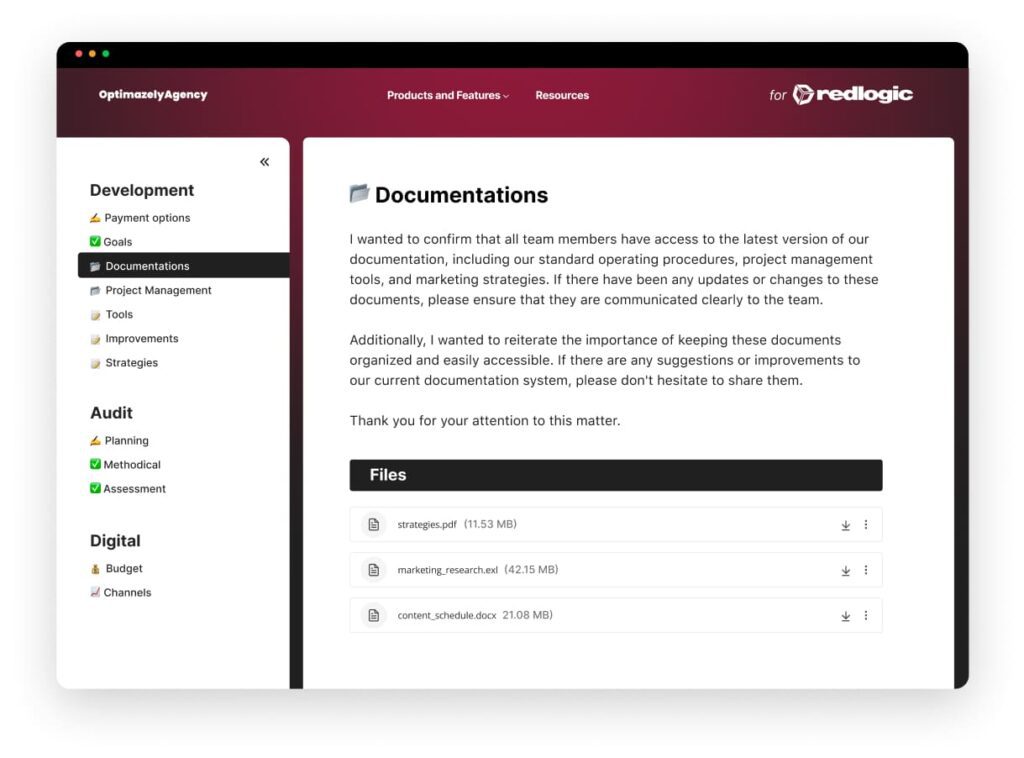
How Can Knowledge Bases Benefit Your Business?
As we have explored in previous articles about knowledge bases, there are tons of benefits to implementing a knowledge base in your business, but we believe that the most prominent ones are these two:
- Increased staff efficiency: A knowledge base allows employees to quickly find the information they need to complete a task, reducing the time and effort required to find answers. This can increase the efficiency of your customer support teams and the business as a whole. With a properly updated knowledge base, you can expect less nagging from that colleague who always has a question for you. Yeah, that’s right, looking at you, Ryan!
- Improved customer satisfaction: A knowledge base can be used to promote self-service by providing customers with quick access to information and allowing them to find answers to their frequently asked questions, thus reducing the need for contacting support customer service (a.k.a. your awesome support team). This can improve customer experience and satisfaction, which in the long run increases customer loyalty as well.
So, with these two benefits in mind, as Chandler Bing would say, could knowledge bases be any more awesome?!
What Makes a Good Knowledge Base Example?
So now that we know how awesome a knowledge base can be, let’s talk about what makes a good knowledge base example, that is, what features a knowledge base software needs to have so that it provides a great user experience and all the benefits discussed above. In our professional opinion, knowledge bases need to have the following:
- Accurate and up-to-date information: The most important aspect of a good knowledge base is that it contains accurate and current information. Users rely on the information provided in a knowledge base, and if it is incorrect or outdated, it can lead to confusion and errors. It can be terribly counterproductive to have users rely on outdated information.
- User interface and mobile responsiveness: A nice user interface is crucial for providing a positive user experience. A well-designed interface will make it easy for users to find the information they need, understand it clearly and quickly, and will minimize frustration. And, of course, a customer-facing knowledge base must be responsive and optimized for different devices like tablets and smartphones. Your online users are probably living in the 21st century, so your knowledge base has to as well.
- Easy navigation and search function: A good knowledge base should be easy for users to navigate and find the information they need. This can be achieved through clear organization, intuitive labels, breadcrumbs, a powerful search function, etc. Remember that not everyone is as tech-savvy as you, especially Ryan, right?
- Concise and clear language: The language used in a knowledge base should be clear and easy to understand for the target audience, even when talking about complex issues. Avoid using jargon or technical terms unless they are necessary and explained in layman’s terms.
- Consistency in formatting and terminology: A consistent format and use of terminology throughout the knowledge base will make it easier for users to find and understand the information they need. This includes consistent use of headings, bullet points, and font sizes.
- Regular updates and maintenance: A knowledge base is a living document that requires regular updates and maintenance to ensure that the information it contains is accurate and current. This is especially true if you use a WordPress-based knowledge base, as WP plugins and themes need constant updates and care.
- User feedback and suggestions for improvement: Some knowledge base platforms allow for user feedback and suggestions for improvement, and we believe this is fundamental. This can help identify inaccuracies or areas that need more detail, and can help improve the overall quality of the information you’re feeding your users.
- Integration with other systems and tools: A good knowledge base should be integrated with other systems and tools. For instance, this can include customer relationship management (CRM) systems, email marketing platforms, help desk software, or other internal tools. With these integrations, your business can save tons of time and make more $$$.
- Accessibility for users with disabilities: Although we know that achieving 100% accessibility is tough, we strongly believe that a decent knowledge base should be accessible for users with disabilities. This includes providing alternative text for images, closed captioning for videos, and providing the ability to adjust font size and contrast.
- Multi-language support for global audiences: Voulez-vous conquérir le monde? Sorry, we mean, would you like to conquer the world? You’d better provide multi-language support! If you have a customer-facing knowledge base and your target audience is global, your knowledge base should be available in multiple languages. C’est la vie!
10 Great Knowledge Base Examples
Let’s now take a look at 10 knowledge bases you can find online which are great examples, each in their own way and for different reasons.
FuseBase Knowledge Base

This knowledge base example contains a large number of support articles and vast amounts of information, yet its UI’s look and feel makes it visually pleasant. Also, the articles’ layout, with a search box and a complete sidebar and table of contents, provides users with a wonderful browsing experience. And last but not least, at the end of each knowledge base article, if you haven’t found the answer to your query yet, there’s a direct link to open a ticket and get direct support from the FuseBase team, providing that personal touch that some help centers tend to lack.
Why we like it:
- Wonderful user interface;
- Easy navigation thanks to sidebar and table of contents;
- Articles enriched with images, GIFs and videos;
- Direct link to request support;
- Prominent search bar present on every page;
- Clear organization of categories on the homepage.
Key lessons:
- Knowledge bases can save time and resources, but it’s usually a great idea to provide users with the opportunity to contact the support team directly;
- You can use GIFs over images or videos to enrich your articles. They’re especially useful to provide short step-by-step instructions.
Canva Help Center
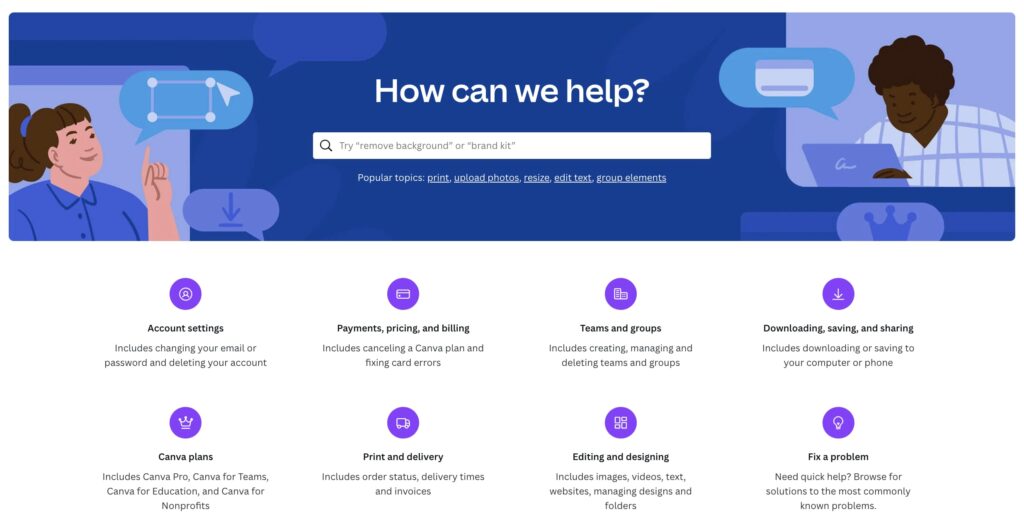
Canva’s help center is one of the best knowledge base examples. Not only does it provide a comprehensive list of topics and other resources to help you with your designs, it also features an interactive search bar that allows you to quickly find the content you’re looking for. Their support articles offer concise yet detailed instant answers to common questions users have, as well as helpful internal links to additional resources.
Why we like it:
- Extremely comprehensive knowledge base;
- Interactive search bar with suggestions as you type;
- Announcement banner for updated news about support;
- Clear and uncluttered user interface;
- Well organized into nested categories and subcategories;
- Direct link to popular articles;
- User feedback functionality at the end of each article;
- Clear, user-friendly language;
- 100% multilingual.
Key lessons:
- The way you organize the information within a knowledge base will make all the difference, especially when you have hundreds or thousands of support articles;
- If your product or service is used across borders, multilingual content is a must.
Infinity’s Help Center
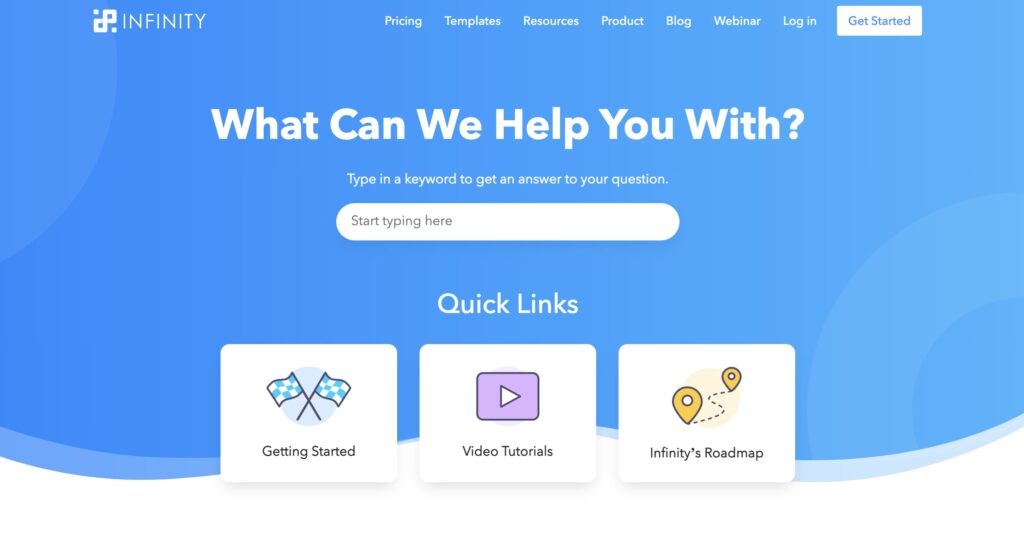
Our colleagues at Infinity have done a great job with their support knowledge base. With their lovely design and well-organized support page, they have created a comprehensive knowledge base for their users, with articles enriched with static images, GIFs, videos, etc. Furthermore, their interactive search bar is present not only on the knowledge base homepage, but also inside each article, which saves time having to go back and forth. These knowledge base articles also link to next/previous articles at the end and have a left sidebar to related support categories.
Why we like it:
- Great user interface;
- Well-organized main page;
- Table of contents at the beginning of each article;
- Rich media in the form of images and videos;
- Call-out boxes to draw attention to essential information;
- Live chat available on main support page.
Key lessons:
- Table of contents are extremely useful in long support articles;
- An image is worth a thousand words, so make sure to use them in your knowledge base articles.
Buffer’s Help Center
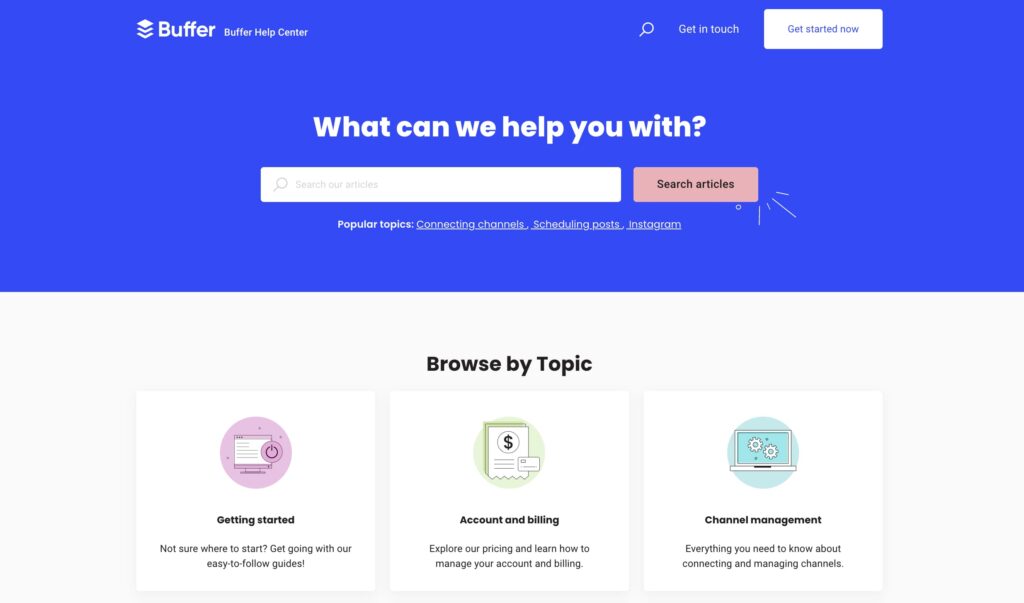
This social media scheduler does a hell of a job providing its users with a useful, self-service resource and help center. With a simple yet colorful design, Buffer’s knowledge base has a clear, easy-to-navigate interface, despite containing a considerable number of articles. And we think it’s a great knowledge base example.
Why we like it:
- Their branding is clearly present in this knowledge base.
- The main support page has a very visual design, making it easier to access the several categories.
- Support articles feature the author and the date AND time of publication or latest update. This is quite unique, as not every knowledge base includes either of these elements.
- Direct link to “recently viewed articles”, which is a section built dynamically as you browse articles in their knowledge base. This is also very unique and can come in really handy.
- Call-out and colored warning boxes make essential information stand out from the rest of the content.
Key lessons:
- Updated articles are essential, obviously, but showing your users when that article was updated is also important, so they know they’re reading up-to-date information. This is especially true when creating a knowledge base for a software company.
- If you care about your branding, don’t forget about it in your support articles. Make sure to be consistent, at least, with the colors, visuals, font, etc.
Grammarly’s Support Center
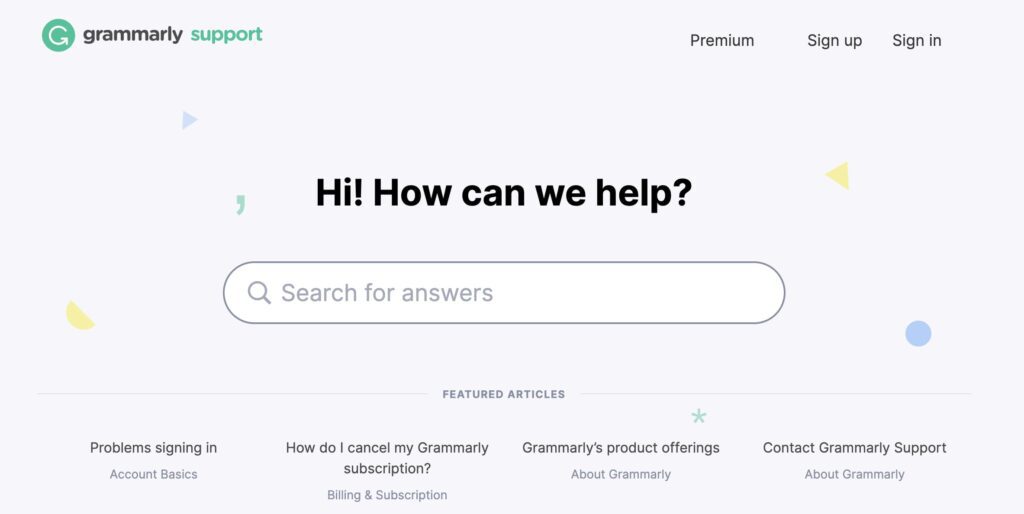
Grammarly does a wonderful job supporting its users thanks to its knowledge base. Its on-brand minimalistic design facilitates browsing the hundreds of articles contained in this knowledge base example which, at the same time, rakes in tens of thousands of organic visits from search engines. Furthermore, their main support page is a breath of fresh air, which they achieve by offering only a few clickable elements: search bar, four featured articles and six support categories. That’s it.
Why we like it:
- Clean and intuitive user interface;
- Massive SEO presence thanks to its relevant content;
- 100% on brand;
- User feedback functionality;
- “Submit a request” link at the end of each support article.
Key lessons:
- Most of the time, a KISS (Keep It Simple, Stupid!) will work wonders when organizing a knowledge base;
- Use your online knowledge base to attract organic traffic from search engines.
The UK’s Government Website
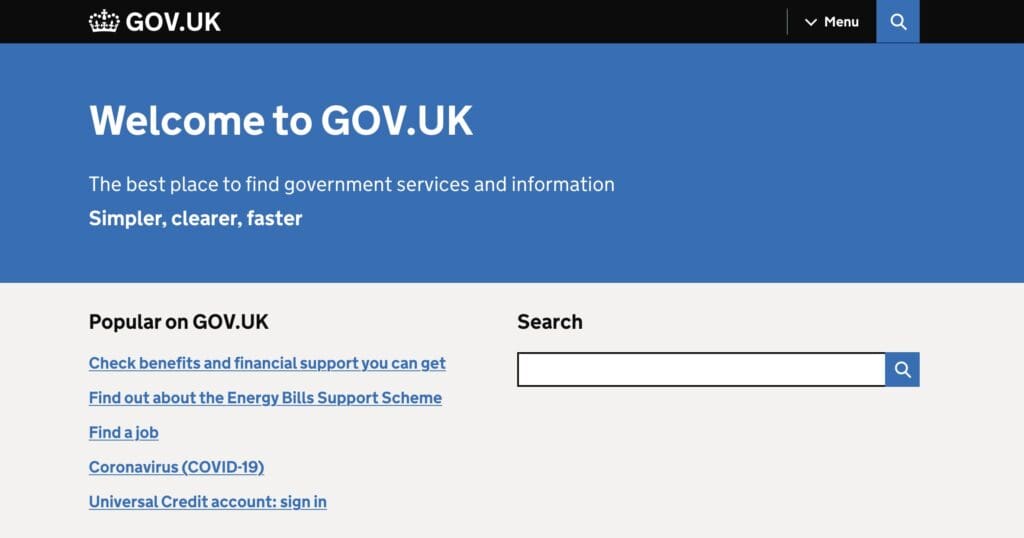
Creating a support center for a whole country is no mean feat, that’s for sure. And although some improvements should probably be implemented, we believe the UK’s government website is one of the best knowledge base examples to show how knowledge bases act or should work when they’re used in national entities to support citizens.
Why we like it:
- Snappy browsing experience with zero loading time;
- Effective interlinking to create a step-by-step browsing experience;
- Perfect use of breadcrumbs at the top of each article;
- Great organization despite having thousands of support articles;
- Feedback feature;
- “Report a problem” button at the end of each article.
Key lessons:
- Instant loading experience is essential for users trying to find the right information to solve their problems, especially when your site is receiving tens of thousands of visitors every single day. Can you imagine the number of unhappy, frustrated users a site like that would leave if its support pages loaded too slowly?
- When dealing with thousands of important support articles involving different official paperwork processes, applications, etc., interlinking can make all the difference when guiding users through all the different steps.
Shopify Help Center

Shopify help center is a one-stop shop (pun intended!) for individuals and businesses looking to create and manage their online stores. This customer knowledge base example offers a wide range of articles, tutorials and guides on various complex topics like setting up a store, designing and customizing it, managing inventory, processing payments, and shipping orders. One of the things that stands out is that the help center also links to a community forum where users can ask questions and share tips and advice with other Shopify users.
Why we like it:
- Visually simple yet appealing;
- FAQ section on main page;
- Connected to user community;
- Translated into 21 languages;
- Great use of breadcrumbs;
- Search bar present on every page;
- CTA for new users at the end of each article;
- Complete sidebar present in every support article.
Key lessons:
- Communities can be a great asset when you have a large customer base. Different users can help each other to solve problems, which can take some weight off direct support queries.
- Showing visitors the most common questions from other users can save them time looking for an answer, especially when you have hundreds of articles.
WhatsApp Help Center
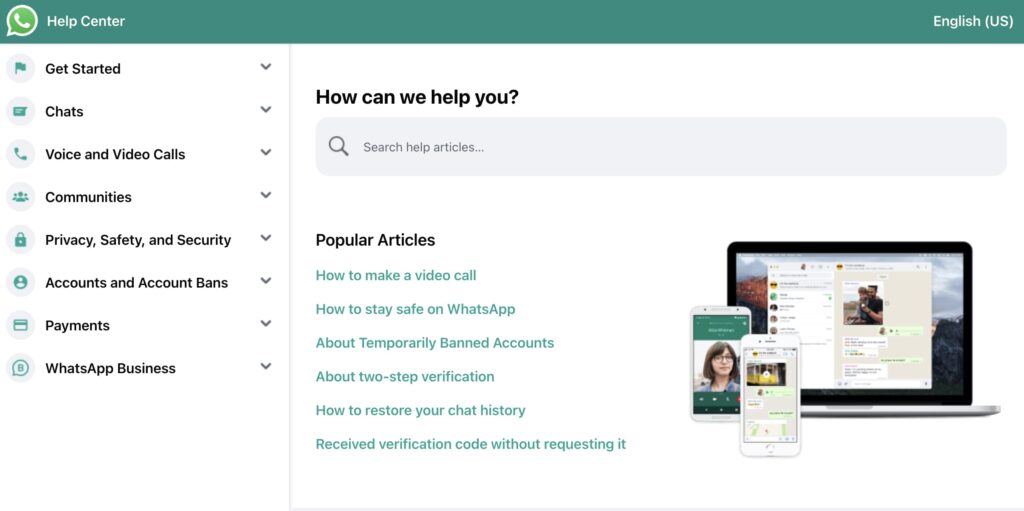
WhatsApp’s help center is a user-friendly resource for individuals looking to learn more about using this popular instant messaging app. This knowledge base example offers a wide range of articles, tutorials and guides on various topics such as account setup, security, privacy, and troubleshooting. One of the interesting things about this knowledge base is that users can also access the help center through the app itself, making it easily accessible and searchable.
Why we like it:
- Help center is accessible from mobile app;
- Clear interface and layout;
- Use of icons facilitates browsing experience ;
- Nested hierarchy of categories, subcategories and articles;
- Articles written for different devices, accessible through separate tabs.
Key lessons:
- Your help center needs to be where your users are. WhatsApp is a smartphone app, so it makes total sense to optimize it and make it accessible on mobile devices.
- Carefully designed icons and other small visual elements can help many users browse your knowledge base more easily.
Google’s Support Center
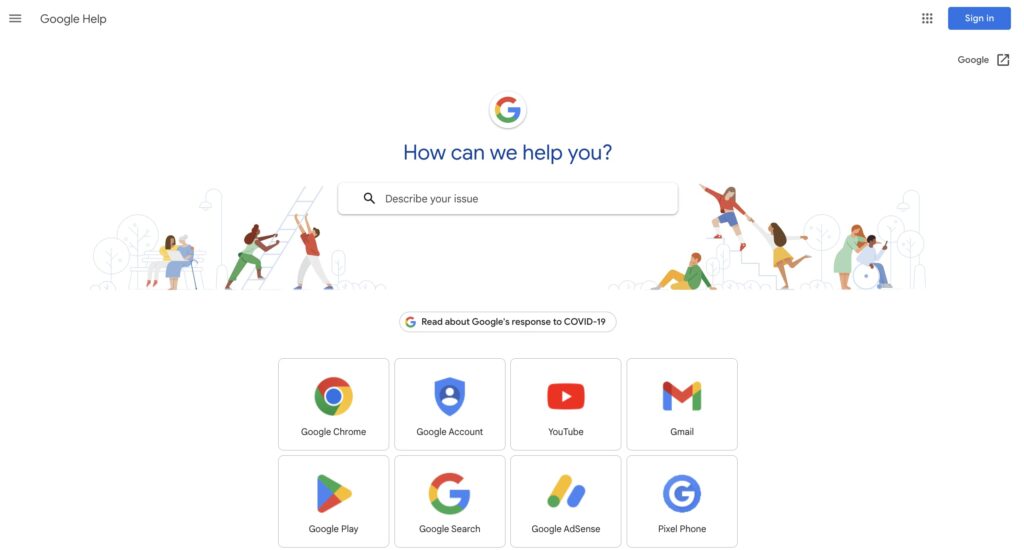
Google.com is the most visited website in the world, which is not surprising nowadays. So how do you create a knowledge base for the most popular site online? We think Google has done a good job out of it. First, given how many products and services they have, they list all of these using their characteristic icon logos, which makes it easier for users to know where to go. And once you access one of these products, you get a list of accordion tabs listing all the subcategories and support articles. We believe it’s a good way to structure such an amount of relevant information. And just like Shopify, some of their sections link to online communities where users can help each other.
Why we like it:
- Great categorization of vast amounts of information to keep it simple;
- Use of tabs, accordions FAQs, etc. within the articles themselves;
- Related resources links at the end of most articles;
- Various ways to provide feedback as a user at the end of each article;
- Right sidebar linking to other articles in the same category;
- Support community linked to the support center.
Key lessons:
- Make organization and categorization a priority when you have loads of information in your knowledge base;
- Apart from images and videos, you can enrich your articles with tabs and accordions instead of creating other similar articles.
Similarweb’s Knowledge Center
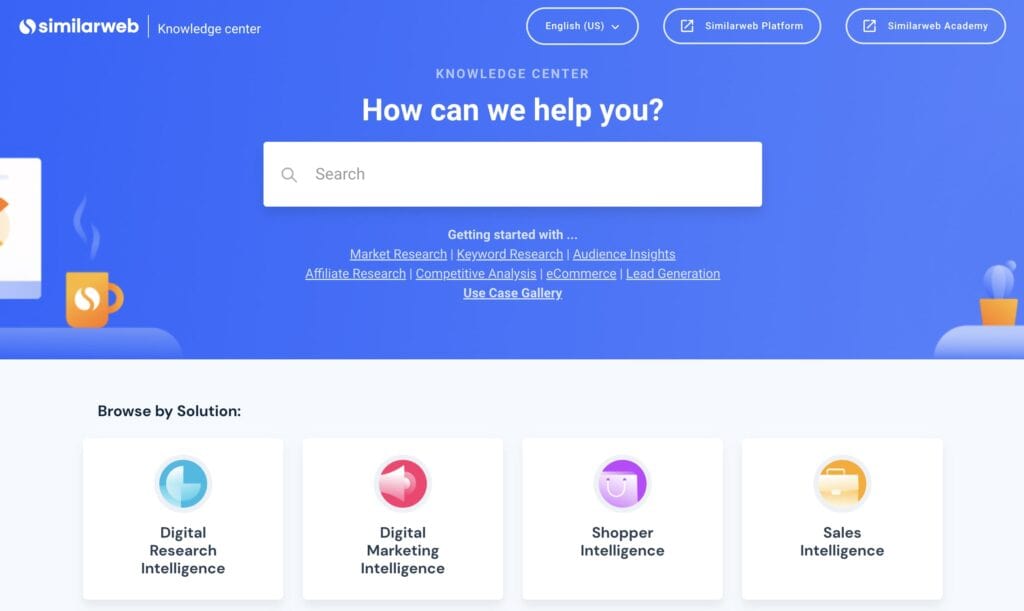
The popular online marketing platform features another great knowledge base example. In fact, it might be one of the best knowledge bases we have come across. Apart from having a perfectly branded help center, this knowledge base allows visitors to browse by solution, as Similarweb offers different products, or by topic. One thing that stands out and that we haven’t seen in other customer knowledge bases is the presence of a glossary, which can be quite useful not only to help users understand key terms, but also for SEO purposes, as a well-thought and carefully written glossary can attract a considerable amount organic traffic.
Why we like it:
- Allows users to browse by products or topics;
- Comprehensive business and marketing glossary;
- CTA to contact support;
- Prominent search bar;
- Recently viewed articles block;
- Sticky sidebar, useful for longer articles.
Key lessons:
- Sometimes you need to offer different criteria for browsing your support articles (by product, by service, by topic, by device, etc.);
- Creating a glossary of relevant terms as short blog posts can help you both to educate your users and to attract and convert new ones.
Create Your Knowledge Base with FuseBase
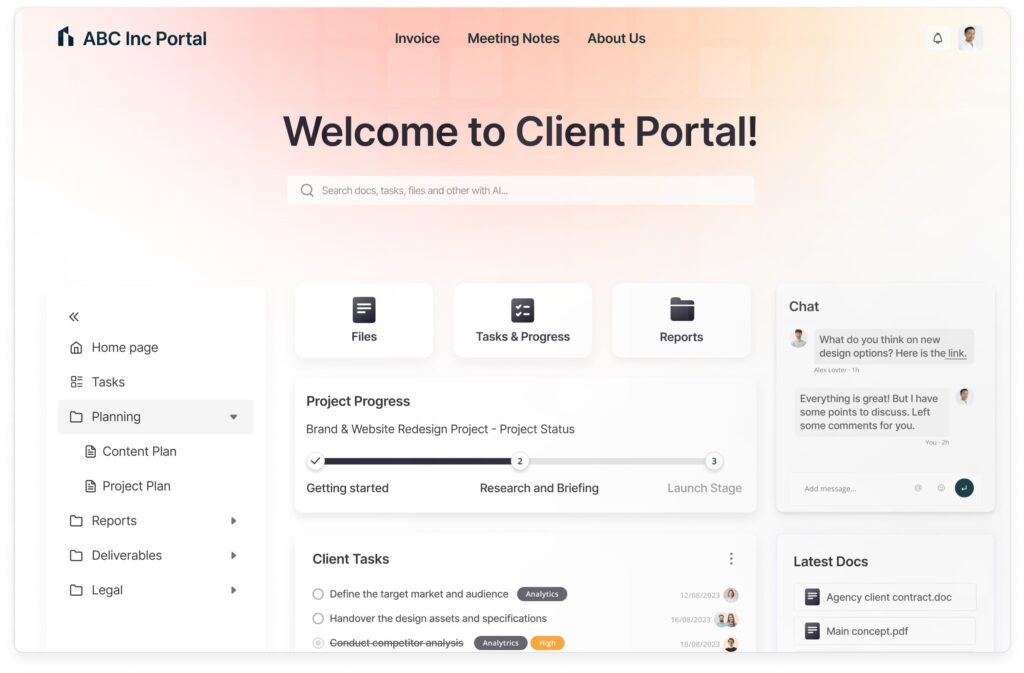
FuseBase provides you with the necessary tools to create a great knowledge base. Whether you need internal knowledge bases for your staff or an external knowledge base for your clients or users, with FuseBase you can create any type of support article which you can enrich with images, videos, call-out boxes, accordions, embeds, etc. And it can be used as well as a project management software which integrates seamlessly with your knowledge base.
Spoiler alert: it’s so much better than Google Docs!
Besides, FuseBase’s nested folders and linking capabilities make it easy to organize and categorize support articles in the best possible way for your users.
Organize an effective knowledge base for your business with FuseBase!
It’s a Wrap!
In conclusion, an effective knowledge base is like a well-stocked toolbox – it gives you the tools you need to tackle any problem that comes your way (Okay, Ryan? Go solve your own problems, buddy!). Whether you’re looking for a comprehensive guide to a particular topic, or simply need a quick answer to a specific question, a well-designed knowledge base can be an invaluable resource. So if you’re a business looking to improve customer service or your support team, it’s worth taking the time to explore some of the excellent knowledge base examples we’ve listed in this article.
Follow FuseBase Platform on Linkedin for the latest articles and updates!
Found it useful? Share the article with your community
Subscribe to our blog!
Get weekly tips and insights on how to grow your business